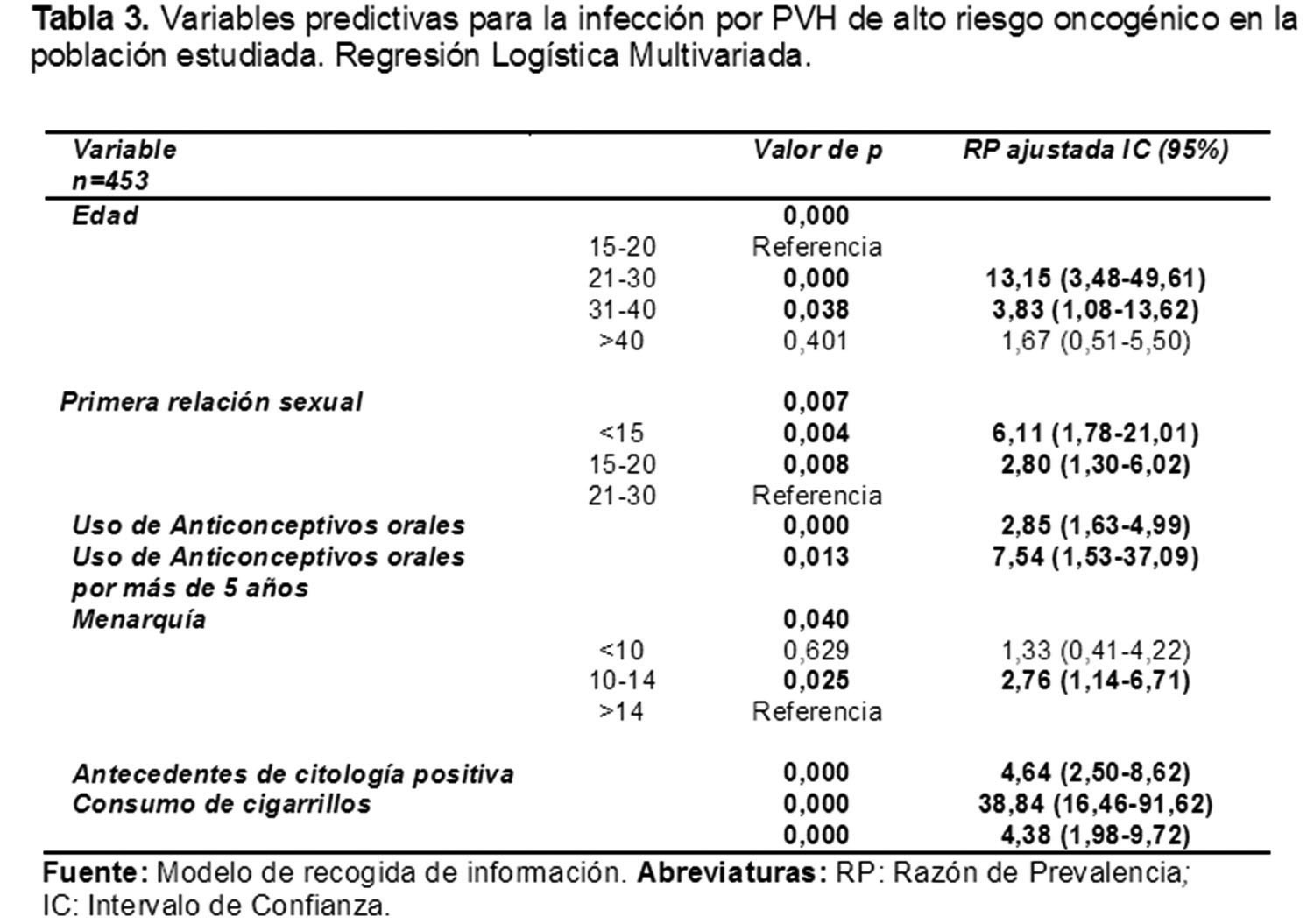Papilomavirus humanos y otros factores asociados al desarrollo de lesiones cervicouterinas en mujeres cubanas.
Resumen
Objetivo: Determinar la circulación de genotipos de Papilomavirus humanos (PVH) y los factores sociodemográficos, epidemiológicos y clínicos asociados con la presencia de lesiones intraepiteliales cervicales en un grupo de mujeres cubanas.
Materiales y Métodos: Estudio de corte transversal en población femenina de 4 municipios de La Habana. Se incluyeron 519 mujeres entre 15 y 59 años con una citología cervical negativa en los dos años anteriores al estudio. Se les realizó citología cervical y detección de PVH. Para la detección viral se realizó Reacción en Cadena de la Polimerasa (PCR) empleando los oligonucleótidos MY09/11. El genotipado se realizó mediante hibridación Dot Blot.
Resultados: El 41,6% de la población estudiada se diagnosticó con citología con citología positiva, de ellas el 58,8% con lesiones de alto grado. En el 66,3% de las mujeres estudiadas se detectó algún tipo de PVH, asociado significativamente con la citología positiva. Se identificaron 30 genotipos diferentes de PVH, con predominio de los genotipos oncogénicos PVH 16 (41,0%), 31 (11,6%) y 18 (10,2%). Los predictores de riesgo para la infección con estos genotipos fueron: el inicio de las relaciones sexuales antes de los 15 años, la menarquía entre 10 y 14 años, el consumo de cigarrillos y de anticonceptivos orales. En mujeres menores de 20 años predominaron las lesiones de alto grado.
Conclusiones: Los resultados del presente estudio apoyan el uso de la vacunación contra PVH y sugiere la realización de investigaciones basadas en estudios virológicos y citológicos en mujeres menores de 25 años.
Citas
1. Bess S, Gran MA, Martínez MM, Alonso I, Lopez LM, Torres RM, et al. Anuario Estadístico de Salud 2014. Especial ed. La Habana: Oficina Nacional de Estadísticas e Información de la Dirección Nacional de Registros Médicos del Ministerio de Salud Pública de Cuba; 2015. p. 66-83. Disponible en: http://files.sld.cu/bvscuba/files/2015/04/anuario-estadistico-de-salud-2014.pdf.
2. Schmitt M, Depuydt C, Benoy I, Bogers J, Antoine J, Arbyn M, et al. Prevalence and viral load of 51 genital human papillomavirus types and three subtypes. Int J Cancer. 2013;132 (10):2395-403. Disponible en: http://www.ncbi.nlm.nih.gov/pubmed/23034864.
3. Zur Hausen H. Papillomaviruses in the causation of human cancers - a brief historical account. Virology. 2009;384(2):260-5. Disponible en: http://www.sciencedirect.com/science/article/pii/S0042682208007721.
4. Howley PM, Schiller JT, Lowy DR. Papillomavirus. In: Knipe DM, Howley PM, editors. Fields Virology. 6th ed. Philadelphia, USA: Lippincott Williams & Wilkins; 2013. p. 1662-700. Disponible en: http://www.worldcat.org/title/fields-virology/oclc/825740706.
5. Vargas-Hernandez VM, Acosta-Altamirano G, Moreno-Eutimio MA, Vargas-Aguilar VM. New guidelines in regard to cervical cancer screening. Cir Cir. 2014; 82(4): 453-9. Disponible en: http://www.ncbi.nlm.nih.gov/pubmed/25167359.
6. Soto Y, Torres G, Kouri V, Limia CM, Goicolea A, Capo V, et al. Molecular Epidemiology of Human Papillomavirus Infections in Cervical Samples From Cuban Women Older Than 30 Years. J Low Genit Tract Dis. 2014;18(3):210-17. Disponible en: http://www.ncbi.nlm.nih.gov/pubmed/24270200.
7. Soto Y, Mune M, Morales E, Goicolea A, Mora J, Sanchez L, et al. Human Papillomavirus infections in Cuban women with cervical intraepithelial neoplasia. Sex Transm Dis. 2007;34(12):974-6. Disponible en http://www.ncbi.nlm.nih.gov/pubmed/18077849.
8. Ríos MA, Hernández M, Aguilar FO, Silveira M, Amigó M, Aguilar K. Tipos de papilomavirus humanos más frecuentes en muestras cubanas de cáncer cervical. Rev Cubana de Obstet y Ginecol. 2010;36(2):104-11. Disponible en: http://scieloprueba.sld.cu/scielo.php?script=sci_arttext&pid=S0138-600X2010000200009&lng=es.
9. Papanicolaou GN. A NEW PROCEDURE FOR STAINING VAGINAL SMEARS. Science. 1942;95(2469):438-9. Disponible en http://www.ncbi.nlm.nih.gov/pubmed/17842594
10. Anuario Demográfico de Cuba 2007. In: Estadísticas Dd, editor. La Habana: Oficina Nacional de Estadísticas (ONE). Dirección Nacional de Registros Estadísticos de la República de Cuba; 2008. Disponible en http://www.cuba-economia.org/documentos/anuarios-demograficos/anuario-demografico-2007
11. Cabezas E, Camacho T, Santana A, Borrajero I, Aguilar F, Romero T, et al. Programa Diagnóstico Precoz del Cáncer de Cuello del Útero en Cuba. In: Cabezas Cruz E, editor. 1st ed. Havana: Cuban Ministry of Public Health 1999. Disponible en: http://www.bvs.sld.cu/revistas/gin/vol37_2_11/gin11211.htm.
12. Milutin-Gasperov N, Sabol I, Halec G, Matovina M, Grce M. Retrospective study of the prevalence of high-risk human papillomaviruses among Croatian women. Coll Antropol. 2007;31 Suppl 2:89-96. Disponible en: http://www.ncbi.nlm.nih.gov/pubmed/17598510.
13. Gravitt PE, Peyton CL, Alessi TQ, Wheeler CM, Coutlee F, Hildesheim A, et al. Improved amplification of genital human papillomaviruses. J Clin Microbiol. 2000;38(1):357-61. Disponible en: http://www.ncbi.nlm.nih.gov/pubmed/10618116.
14. Chaiwongkot A, Pientong C, Ekalaksananan T, Kongyingyoes B, Thinkhamrop J, Yuenyao P, et al. Evaluation of primers and PCR performance on HPV DNA screening in normal and low grade abnormal cervical cells. Asian Pac J Cancer Prev. 2007;8(2):279-82. Disponible en: http://www.ncbi.nlm.nih.gov/pubmed/17696746.
15. Wold-Medical-Association. Declaration of Helsinki. Ethical Principles for Medical Research Involving Human Subjects. 2008; Available from: http://www.wma.net/en/30publications/10policies/b3/7c.pdf].
16. Giambi C, Donati S, Carozzi F, Salmaso S, Declich S, Atti ML, et al. A cross-sectional study to estimate high-risk human papillomavirus prevalence and type distribution in Italian women aged 18-26 years. BMC Infect Dis. 2013;13:74. Disponible en: http://www.ncbi.nlm.nih.gov/pmc/articles/PMC3599585/.
17. Lee SJ, Yeo SG, Park DC. High-risk human papillomavirus infection in low risk women: incidence, patient characteristics, and clinical meaning for cervical cancer. Int J Med Sci. 2012;9(1):103-7. Disponible en: http://www.ncbi.nlm.nih.gov/pubmed/22211097.
18. Deluca GD, Marin HM, Blanco NS, Basiletti JA, Gonzalez JV, Merino AL, et al. Distribution of human papillomavirus genotypes in women with cervical alterations from north Argentina. Indian J Med Microbiol. 2013;31(2):138-41. Disponible en: http://www.ncbi.nlm.nih.gov/pubmed/23867669.
19. Oliveira FA, Ehrig V, Lang K, Heukelbach J, Stoffler-Meilicke M, Ignatius R, et al. Human papillomavirus genotype distribution and risk factors for infection in women from a small municipality in north east Brazil. Int J STD AIDS. 2012;23(9):e5-10. Disponible en http://www.ncbi.nlm.nih.gov/pubmed/23033534.
20. de Mendonca VG, Guimaraes MJ, de Lima Filho JL, de Mendonca CG, Martins DB, Crovella S, et al. [Human papillomavirus cervical infection: viral genotyping and risk factors for high-grade squamous intraepithelial lesion and cervix cancer]. Rev Bras Ginecol Obstet. 2011;32(10):476-85. Disponible en: www.ncbi.nlm.nih.gov/pubmed/21271154.
21. Chironna M, Tafuri S, De Robertis AL, Sallustio A, Morea A, Napoli A, et al. Prevalence of HPV infection and genotype distribution in women from Africa seeking asylum in Puglia, Italy. J Immigr Minor Health. 2013;15(1):159-63. Dsiponible en: http://www.ncbi.nlm.nih.gov/pubmed/22869450.
22. Pierre Joseph N, Belizaire M, Porter CL, Walsh JP, Esang M, Goff G, et al. Ethnic differences in perceived benefits and barriers to HPV vaccine acceptance: a qualitative analysis of young African American, Haitian, Caucasian, and Latino men. Clin Pediatr (Phila). 2014;53(2):177-85. Disponible en: http://www.ncbi.nlm.nih.gov/pubmed/24403292.
23. Coser J, da Rocha Boeira T, Simon D, Kazantzi Fonseca AS, Ikuta N, Lunge VR. Prevalence and genotypic diversity of cervical human papillomavirus infection among women from an urban center in Brazil. Genet Mol Res. 2013;12(4):4276-85. Disponible en: http://www.ncbi.nlm.nih.gov/pubmed/23479144.
24. De Azevedo AE, Carneiro FP, Neto FF, Bocca AL, Teixeira LS, de Queiroz Mauricio Filho MA, et al. Association between human papillomavirus infection and cytological abnormalities during early follow-up of invasive cervical cancer. J Med Virol. 2012;84(7):1115-9. Dsiponible en: http://www.ncbi.nlm.nih.gov/pubmed/22585730.
25. Vinodhini K, Shanmughapriya S, Das BC, Natarajaseenivasan K. Prevalence and risk factors of HPV infection among women from various provinces of the world. Arch Gynecol Obstet. 2012;285(3):771-7. Disponible en: http://www.ncbi.nlm.nih.gov/pubmed/22159694.
26. Marks M, Gravitt PE, Gupta SB, Liaw KL, Kim E, Tadesse A, et al. The association of hormonal contraceptive use and HPV prevalence. Int J Cancer. 2010;128(12):2962-70. Disponible en: http://www.ncbi.nlm.nih.gov/pubmed/20734390.
27. Wei L, Griego AM, Chu M, Ozbun MA. Tobacco exposure results in increased E6 and E7 oncogene expression, DNA damage and mutation rates in cells maintaining episomal human papillomavirus 16 genomes. Carcinogenesis. 2014;35(10):2373-81. Dsiponible en: http://www.ncbi.nlm.nih.gov/pmc/articles/PMC4178472/
28. Moktar A, Singh R, Vadhanam MV, Ravoori S, Lillard JW, Gairola CG, et al. Cigarette smoke condensate-induced oxidative DNA damage and its removal in human cervical cancer cells. Int J Oncol. 2011;39(4):941-7. Dsiponible en: http://www.ncbi.nlm.nih.gov/pmc/articles/PMC3760590/.
29. Oliveira-Silva M, Lordello CX, Zardo LM, Bonvicino CR, Moreira MA. Human Papillomavirus in Brazilian women with and without cervical lesions. Virol J. 2011;8:4.Disponible en: http://www.ncbi.nlm.nih.gov/pubmed/21208414.
30. Badano I, Pedrozo RW, Ruiz Diaz LS, Galuppo JA, Picconi MA, Campos RH, et al. Human papillomavirus (HPV) detection and Papanicolaou cytology in low-resource women in Posadas city, Misiones, Argentina. Rev Argent Microbiol. 2011;43(4):263-7. Dsiponible en: http://www.ncbi.nlm.nih.gov/pubmed/22274823.
31. Mendoza LP, Arbiza J, Paez M, Kasamatsu E, Castro A, Gimenez G, et al. Distribution of human papillomavirus genotypes in Paraguayan women according to the severity of the cervical lesion. J Med Virol. 2011;83(8):1351-7. Disponible en: http://www.ncbi.nlm.nih.gov/pubmed/21618554.

Descargas
Publicado
Cómo citar
Número
Sección
Licencia
La aceptación de un trabajo para su publicación en Panorama. Cuba y Salud supone que Los autores/as conservarán sus derechos de autor y garantizarán a la revista el derecho de primera publicación de su obra, el cual estará simultáneamente sujeto a la Licencia de reconocimiento de Creative Commons que permite a terceros compartir la obra siempre que se indique su autor y su primera publicación esta revista.
Los autores/as podrán adoptar otros acuerdos de licencia no exclusiva de distribución de la versión de la obra publicada, siempre que se indique la publicación inicial en esta revista.
Licencia Creative Commons
La Revista Panorama Cuba y Salud se encuentra bajo una
Licencia Creative Commons Reconocimiento-NoComercial 4.0





